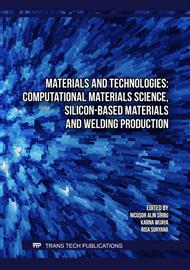[1]
G. Ren, H. Han, Y. Wang, S. Liu, J. Zhao, X. Meng, and Z. Li, Recent Advances of Photocatalytic Application in Water Treatment: A Review, Nanomaterials. 11 (2021) 1804.
DOI: 10.3390/nano11071804
Google Scholar
[2]
Z. Li, X. Meng, and Z. Zhang, Fabrication of Surface Hydroxyl Modified g-C3N4 with Enhanced Photocatalytic Oxidation Activity, Catal. Sci. Technol. 9 (2019) 3979-3993.
DOI: 10.1039/c9cy00550a
Google Scholar
[3]
Z. Li, X. Meng, and Z. Zhang, Fewer-Layer BN Nanosheets-Deposited on Bi2MoO6 Microspheres with Enhanced Visible Light-Driven Photocatalytic Activity, Appl. Surf. Sci. 483 (2019) 572-580.
DOI: 10.1016/j.apsusc.2019.03.245
Google Scholar
[4]
A. Fujishima and K. Honda, Electrochemical Photolysis of Water at a Semiconductor Electrode, Nature. 238 (1972) 37-38.
DOI: 10.1038/238037a0
Google Scholar
[5]
Q. Wang and K. Domen, Particulate Photocatalysts for Light-Driven Water Splitting: Mechanisms, Challenges, and Design Strategies, Chem. Rev. 120 (2020) 919-985.
DOI: 10.1021/acs.chemrev.9b00201
Google Scholar
[6]
E.V. Lavrov, I. Chaplygin, F. Herklotz, V. V. Melnikov, and Y. Kutin, Hydrogen in Single-Crystalline Anatase TiO2, J. Appl. Phys. 131 (2022) 030902.
DOI: 10.1063/5.0086448
Google Scholar
[7]
R.S. Pedanekar, S. K. Shaikh, and K. Y. Rajpure, Thin Film Photocatalysis for Environmental Remediation: A Status Review, Curr. Appl. Phys. 20 (2020) 931-952.
DOI: 10.1016/j.cap.2020.04.006
Google Scholar
[8]
S. Feizpoor, A. Habibi-Yangjeh, and K. Yubuta, Integration of Carbon Dots and Polyaniline with TiO2 Nanoparticles: Substantially Enhanced Photocatalytic Activity to Removal Various Pollutants under Visible Light, J. Photochem. Photobiol. Chem. 367 (2018) 94-104.
DOI: 10.1016/j.jphotochem.2018.08.017
Google Scholar
[9]
X. Liu and J. Fu, Electronic and Elastic Properties of the Tetragonal Anatase TiO2 Structure from First Principle Calculation, Optik. 206 (2020) 164342.
DOI: 10.1016/j.ijleo.2020.164342
Google Scholar
[10]
M. Janczarek and E. Kowalska, Defective Dopant-Free TiO2 as an Efficient Visible Light-Active Photocatalyst, Catalysts. 11 (2021) 978.
DOI: 10.3390/catal11080978
Google Scholar
[11]
A. Kumar and G. Pandey, A Review on the Factors Affecting the Photocatalytic Degradation of Hazardous Materials, Mater. Sci. Eng. Int. J. 1 (2017) 106‒114.
Google Scholar
[12]
C.L. Pang, Strain and Stress Effects on Single Crystal-Supported Titania and Related Nanostructures, Semicond. Sci. Technol. 35 (2020) 113001.
DOI: 10.1088/1361-6641/ab9faa
Google Scholar
[13]
N. Kelaidis, A. Kordatos, S.-R. G. Christopoulos, and A. Chroneos, A Roadmap of Strain in Doped Anatase TiO2, Sci. Rep. 8 (2018) 12790.
DOI: 10.1038/s41598-018-30747-5
Google Scholar
[14]
V. Kazemlou and A. Phirouznia, Influence of Compression Strains on Photon Absorption of Silicene and Germanene, Superlattices Microstruct. 128 (2019) 23-29.
DOI: 10.1016/j.spmi.2019.01.003
Google Scholar
[15]
J. Pető, G. Dobrik, G. Kukucska, P. Vancsó, A. A. Koós, J. Koltai, P. Nemes-Incze, C. Hwang, and L. Tapasztó, Moderate Strain Induced Indirect Bandgap and Conduction Electrons in MoS2 Single Layers, Npj 2D Mater. Appl. 3 (2019) 1-6.
DOI: 10.1038/s41699-019-0123-5
Google Scholar
[16]
Z. Liu, C. Menéndez, J. Shenoy, J. N. Hart, C. C. Sorrell, and C. Cazorla, Strain Engineering of Oxide Thin Films for Photocatalytic Applications, Nano Energy. 72 (2020) 104732.
DOI: 10.1016/j.nanoen.2020.104732
Google Scholar
[17]
L. Thulin and J. Guerra, Calculations of Strain-Modified Anatase TiO2 Band Structures, Phys. Rev. B 77 (2008) 195112.
Google Scholar
[18]
M. J. Mehl, D. Hicks, C. Toher, O. Levy, R. M. Hanson, G. Hart, S. Curtarolo, and thus, The AFLOW Library of Crystallographic Prototypes: Part 1, Comput. Mater. Sci. 136 (2017) S1-S282.
DOI: 10.1016/j.commatsci.2017.01.017
Google Scholar
[19]
F. Birch, Finite Elastic Strain of Cubic Crystals, Phys. Rev. 71 (1947) 809.
DOI: 10.1103/physrev.71.809
Google Scholar
[20]
A. Grünebohm, M. Siewert, C. Ederer, and P. Entel, First-Principles Study of the Influence of (110) Strain on the Ferroelectric Trends of TiO2, Ferroelectrics. 429 (2012) 31-42.
DOI: 10.1080/00150193.2012.676945
Google Scholar
[21]
S. M. Gupta and M. Tripathi, A Review of TiO2 Nanoparticles, Chin. Sci. Bull. 56 (2011) 1639-1657.
DOI: 10.1007/s11434-011-4476-1
Google Scholar
[22]
Y. Kim, M. Watanabe, J. Matsuda, A. Staykov, H. Kusaba, A. Takagaki, T. Akbay, and T. Ishihara, Chemo-Mechanical Strain Effects on Band Engineering of the TiO2 Photocatalyst for Increasing the Water Splitting Activity, J. Mater. Chem. A. 8 (2020) 1335.
DOI: 10.1039/c9ta11048h
Google Scholar
[23]
G. Rajender and P. K. Giri, Strain Induced Phase Formation, Microstructural Evolution and Bandgap Narrowing in Strained TiO2 Nanocrystals Grown by Ball Milling, J. Alloys Compd. 676 (2016) 591.
DOI: 10.1016/j.jallcom.2016.03.154
Google Scholar



